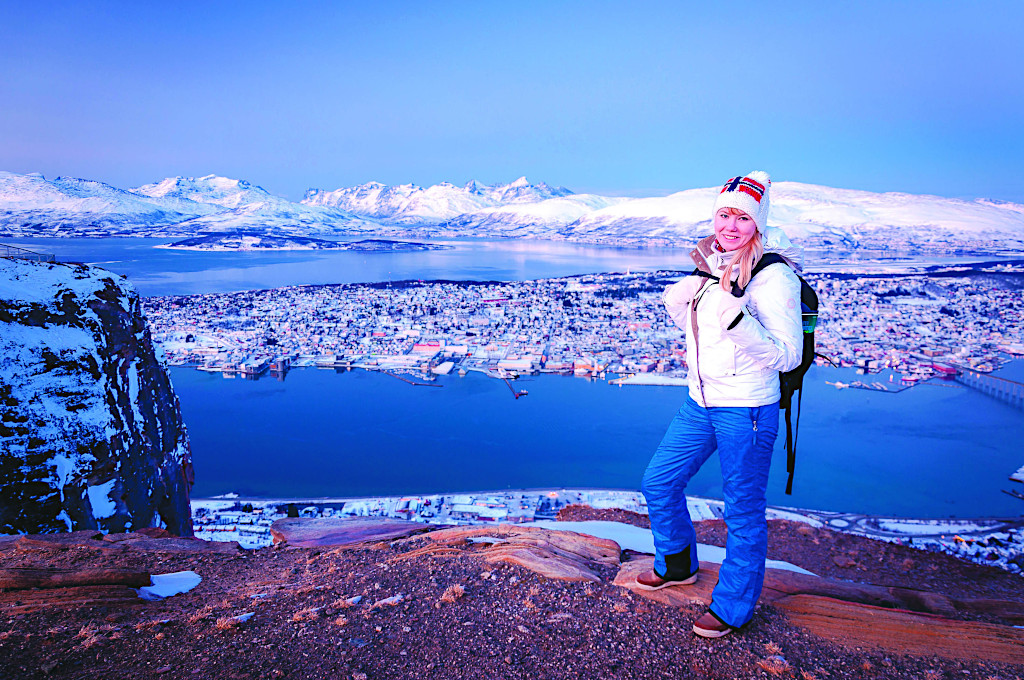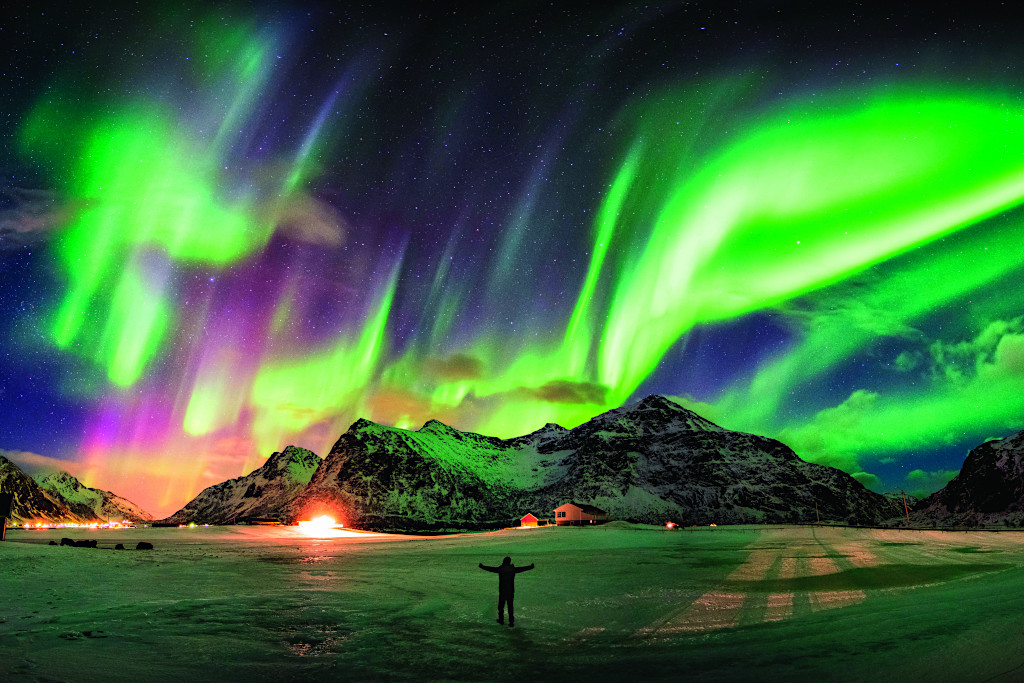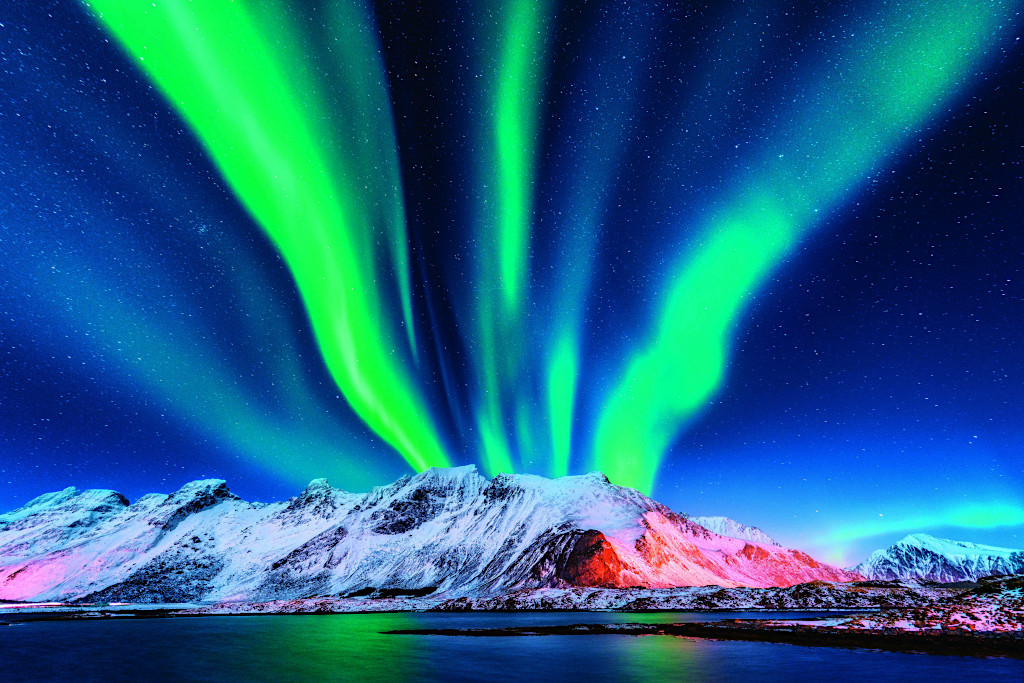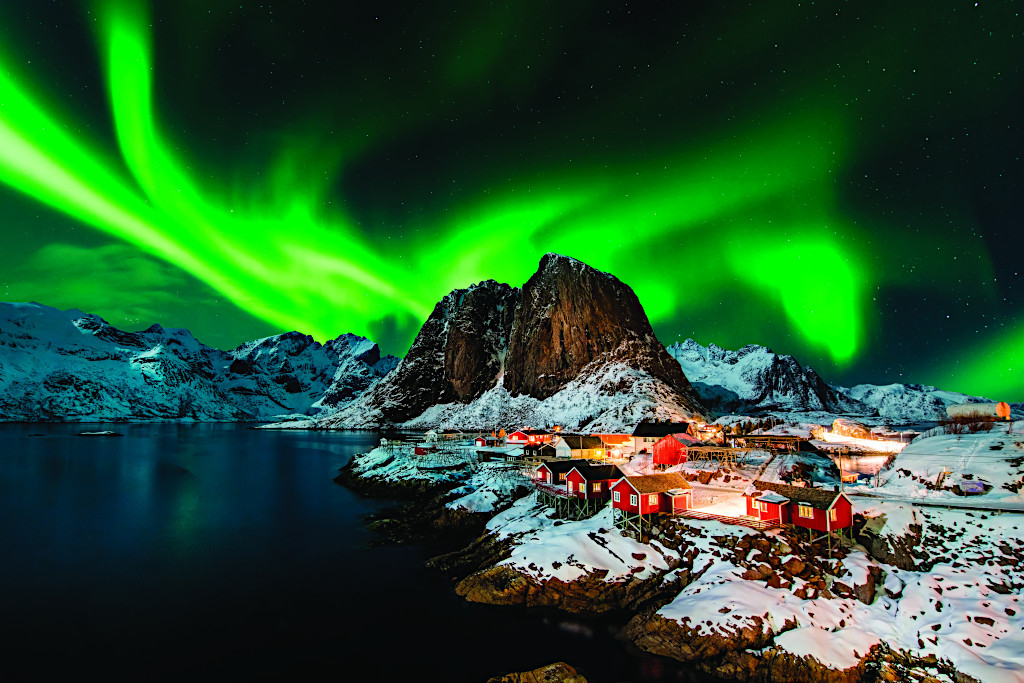Before I ever laid eyes on the northern lights, I asked nearly every Norwegian about them. I heard that the nocturnal spectacle was beauty incarnate. That the lights dance across the sky, washing it in green, purple, and occasionally red, orange, and gold. Sometimes they appear as ribbons, sometimes as broad hazy sheets, sometimes like flames bursting upwards, then rippling back down.
I also heard that the northern lights are unpredictable and elusive. That part is true indeed.
I was on my second deep-winter visit to Arctic Norway. The first journey, aboard a 10-day Hurtigruten (www.hurtigruten.com) coastal cruise, took a full week in February to encounter the glorious aurora borealis. Even then they appeared for only a few hours one night, and for a few minutes another night, but they were extraordinary, and addictive— because three years later, I was back again.
It was January, and I returned for a trip focused more on the lights than other sights, but the aurora’s hard-to-catch reputation lived on. As I explored new Arctic destinations during 20-plus hours of daily darkness, my eyes drifted continually skyward.
The magic of the aurora is attracting ever more travelers to the earth’s poles, but since the southern lights, the aurora australis, are visible from more distant and challenging locales, most opt for North-Pole pursuits. Norway is a prime location. About half of its territory is inside the Arctic Circle and boasts great infrastructure, like airports and harbors, tour companies, and unique sights.
To prep for my aurora-hunting trip, I had to understand more about them. Here’s the short version: Auroral displays begin with a storm on the sun. The resulting solar winds then blast charged particles into space. About 18 hours later, they reach the magnetic field that surrounds the earth, and collide with atmospheric molecules around the planet’s magnetic poles. The collisions, or ionizations, emit brilliant lights that vary in hue, intensity, and location, sometimes wiggling down to latitudes well beyond the Arctic and Antarctic Circles.
It’s sort of like a galactic ribbon dance that starts from the sun, and when it reaches our atmosphere, the ribbons bounce off and ripple across the sky in beautiful colors.

Hiking in Tromso, Norway
Photo: Zinaida Sopina
From the sound of it, the whole process maybe a crap shoot, but through research and my informal polling, I learned a good formula that we earthlings can follow to improve our aurora-spotting chances. For one, August through April are the best months, and traveling above the Arctic Circle’s 66.5 degrees north latitude is optimal.
To actually see the aurora borealis requires clear skies, of course, so it’s wise to plan at least a week-long visit in case of cloud cover. Mind the weather forecast, and in Norway, rely on the highly accurate viewing predictions from NorwayLights.com (website and app), which shares specific hour-by-hour likelihoods for catching the Northern Lights in various Norwegian cities.
Photographing them is another endeavor well worth the effort, just do your homework before you’re standing out in the cold, and know that a tripod and SLR or other camera with manual settings are key.)
And remember to practice patience, because Miss Aurora might be showing off nightly, or she might be as shy as lightning.
Flying Norwegian Air (www.norwegian.com) and hopping on the Flytoget (flytoget.no) airport-express train makes getting to Oslo a snap. I arrived in town in time to enjoy dinner of “nouveau Norwegian” at Bar Brutus (Eiriks gate 2. Tel: 47 22 38 00 88. www.barbrutus.no), and a night at the regal Grand Hotel Oslo (Karl Johans gate 31. Tel: 47-2321-2000. www.grand.no).
The next morning, I flew to the Arctic city of Alta, perched at 69.9 degrees north, and began to embrace my thermal layers like never before. The first day’s temperature was -11° Fahrenheit at noon. Sunshine was present, albeit only as a hazy dusk-like light that lasted only a few hours.
Personally, I love the cold. I naturally run hot and enjoy feeling bundled up with brisk air on my face. But even for me, it took mere minutes to feel the icy air penetrate, first through my heavy-duty gloves, then my double-layered pant legs, then up into the soles of my thermal boots. At subzero temperatures, I found my body involuntarily shaking, and the wind numbing my face. Corny but true: I felt alive!


Aurora Borealis, Lofoten Islands
Photo: Denis Belitsky
My fellow travelers here, on the other hand, were suffering. It seemed like no amount of woolen layers, Thinsulate, scarves, or hot tea could help them sustain more than a few minutes outside. I wondered why they would venture into this climate if they couldn’t take the cold? I think they asked themselves the same question. The answer would prove itself once they saw the lights.
At the head of the Alta Fjord is the town of Alta. It’s a compact city of about 21,000 residents, with a downtown pedestrian mall lined with shops and restaurants. I began by checking into the central Thon Hotel Alta (Labyrinten 6. Tel: 47-7849-4000. www.thonhotels.com), and then enjoying a meal of Artic char with baked cauliflower and potatoes with lingonberry sauce at Stakeriet (Løkkeveien 47a. Tel: 47-4000-5585. www.stakeriet.no).
The Alta Museum (Altaveien 19. 47-4175-6330. www.altamuseum.no) was a good introduction to the area, sharing the region’s natural history and Norwegian art through permanent and temporary exhibits. It’s also built around a series of ancient carved monoliths dating back 2,000 to 6,200 years, making it Northern Europe’s largest and richest rock-carving site, and a UNESCO’s World Heritage site.
The city’s also home to the Cathedral of the Northern Lights (Markedsgata 30. Tel: 47-7844-4270. www.irken.no/alta), a house of worship that opened in 2013. Its architecture is decidedly modern and evokes the Northern Lights both inside and out through materials, lighting, and design. Below ground, BorealisAlta (Tel: 47-4019- 5000. www.borealisalta.no), mixes up the straightforward cathedral experience with an interactive exhibition about the aurora’s history, interpretations, and science.
The next day was a true adventure, driving my own dogsled with Holmen Husky (Holmen 100. Tel: 47 91 76 48 66. holmenhusky.no), an overnight lodge with sledding tours by day or night. If ever you wonder how four 50-pound dogs can pull heavy humans and cargo, these pups will enthusiastically inform you that their vigor knows no bounds. Behind the sled, I quickly learned how to use all my weight and both feet pressed into a cleated rubber mat to “brake” on the snowy trail, and even then the mighty wee beasts could still find traction. By dusk (around 2 P.M. or so), I was on my way to Sorrisniva (Sorrisniva 20. Tel: 47-7843-3378. www.sorrisniva.no), Alta’s igloo hotel and restaurant/bar, to check out the year’s original ice carvings and enjoy a five-course tasting menu in the toasty dining room.
I was glad to have these diversions in Alta, because these first few days were, unfortunately, aurora-free. Such is the nature of northern lights hunting, hit or miss.
The next day brought an unforgettable visit to Europe’s northernmost point, Nord Kapp (www.visitnordkapp.net), or North Cape. At 71.1 degrees north, the cape is about 40 minutes north of Honningsvag. It’s marked by a giant steel-frame globe installed at the edge of a Barents Sea cliff. Yes, it was cold, and whoa, such frigid wind. My inner heat pump was cranking, but even I could only handle a few minutes at a time without gloves before I’d lose feeling in my fingertips. So, fewer selfies, but an authentic Arctic experience.


Northern lights over Skagsanden Beach, Lofoten Islands
Photo: Mumemories.
Inside the visitor center, my peers hunkered down in the café and browsed the big gift shop, and we all explored the subterranean galleries and a panoramic film about this historic area—named Nord Kapp by an English explorer seeking the Northeastern Passage in 1553.
In the town of Honningsvag, I couldn’t resist joining a four-wheel all-terrain vehicle (ATV) night drive with Nord 71° (Fiskeriveien 8. Tel: 47-4728-9320. www.en.71-nord.no), a local tour company that also offers Northern-Lights safaris, and ice-fishing, snowshoing, and snowquad (an ATV with snow tracks) adventures, as well as summer packages.
My Arctic week was winding down as I flew from teeny Honningsvag Airport, which appeared to employ a full winter staff of about four employees, into Tromso. At 69.6 degrees north latitude and with 77,000 residents, it’s Northern Norway’s largest city, and the thirdlargest in the Arctic (after two Russian cities).
This was my second visit to Tromso, and I was glad to return. From its perch on the Tromsoysundet strait, the island city has a few special delights, all walking distance from or along the harbor front. The rustic little Polar Museum (Sondre Tollbodgate 11B. Tel: 47-7762-3360. www.en.uit.no/tmu/polarmuseet) houses artifacts and exhibits about famous Norwegian explorers and local history. At Full Steam, opened in 2019, a former fishery on Bangsund Pier (Sondre Tollbodgate 3. Tel: 47-4783-5055. www.fullsteam.no), was converted into part history exhibit, and restaurant focused on cod, the region’s largest export.
Walking through Tromso leads to discoveries like the town square (aka Stortorget), in winter adorned with new ice-and-snow sculptures, cafés, and bars. I discovered in this historic city colorful wooden houses and other sturdy architecture dating back to the 18th century. By contrast, the Tromso Public Library and Archive (Gronnegt 94. Tel: 47-7779-0900. www.tromso.kommune.no) is airy and modern, with its undulating roof and glowing interiors.
It’s easy to find an affordable hotel in Tromso, with Scandic Ishavshotel (Fredrik Langes gate 2. Tel: 47-7766-64 00. www.scandichotels.no), Clarion Hotel The Edge (Kaigata 6. Tel: 47-7766-8400. www.nordicchoicehotels.no), and several more hotels located by the harbor, both with water or city views, and most including breakfast— naturally, with plenty of smoked fish.
Further down the main avenue of Storgata is Mack (Storgata 4. Tel: 47-8008-0440. www.mack.no), the “world’s northernmost brewery,” and one of the oldest since its first ales were poured in 1877. Don’t miss a trip to its historic Olhallen (brewpub). The Northern Norway Art Museum (Sjogata 1. Tel: 47-7764-7020. www.nnkm.no) houses multi-media works by daring artists representing the region.
Tromso is home to several notable restaurants, but two of the best are casual bistro/bar/event space Bardus (Cora Sandels Gate 4. Tel: 47- 9267-4888. www.bardus.no); and cozy Emma’s Drommekjokken (Kirkegata 8. Tel: 47-7763-7730. www.emmasdrommekjokken.no).
Across the strait, I found myself zipping up the Fjellheisen (www.fjellheisen.no) cable car to Mount Storsteinen; there is no better view than this one, plus there’s a cute café and walking trails.
With only three nights left in Norway, I was admittedly nervous that my chance to see the northern lights was slipping away. I was addicted to my NorwayLights app, hoping to see a little optimism in the forecast. Then, as I strolled out of my hotel around 6 P.M., I saw a handful of people standing still, staring up at the mountain across the strait.
There they were, brilliant bands of green whipping across the heavens. Audible gasps emanated from my fellow skygazers as the aurora borealis’ colors morphed to purple and bits of red. I heard a man with a Norwegian accent say in English, “This is so beautiful. I haven’t seen them so bright like this for a long time.”
It was frigid there on the waterfront. Tromso’s urban lights and long cantilevered bridge illuminated the land and water. But compared to this grand solar gift, this nocturnal phenomenon, earthly flair felt insignificant.
I was seeing the northern lights, as I would for the next two nights. I understood why they were there and the basic astronomy behind them. Yet they defied logic, and left me breathless in wonder. I await the day I get to behold them again.
Be sure to explore VisitNorway.com for regional travel tips, tour packages, recommended guides, seasonal events, attractions, and other trip-planning advice for your Norway adventures.
NOTE: Due to the Covid-19 pandemic, make sure to check the status of each destination and establishment prior to traveling to the area. Many Norwegian cities and businesses are open (fully or partially) at the time of this publication, but their operations are subject to change.


